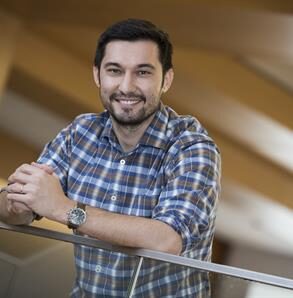MRI machines are a good way to get a glimpse of what's going on inside someone's body, no scalpel required. But if you've ever seen an MRI image, you already know some of the drawbacks.
"Yes, MRIs are noninvasive. They also have pretty bad resolution," said Ulugbek Kamilov, assistant professor in the Preston M. Green Department of Electrical & Systems Engineering and the Department of Computer Science & Engineering in the McKelvey School of Engineering at Washington University in St. Louis.

On the other hand, Raman spectral imaging (RS) can provide detailed information about the goings on at the molecular level, but it's a cumbersome task that, if you wanted to use on human cells, would require a tissue sample.
"The question is: Can we bridge that gap?" Kamilov said. "Can I use an MRI to do a non-invasive scan and get information that's only visible on the molecular scale?"
Scialog: Advancing BioImaging has awarded Kamilov and two co-investigators $50,000 each to put toward answering that question. Along with Benjamin Bartelle at Arizona State University and Lu Wei at the California Institute of Technology, Kamilov will try to bridge that gap.
Scialog is supported by the Chan Zuckerberg Initiative, Research Corporation for Science Advancement and the Frederick Gardner Cottrell Foundation. The three-year initiative aims to accelerate the development of the next generation of imaging technologies.
"We hope these teams of early-career researchers will advance the imaging field's ability to observe and analyze biological processes and help build a much deeper mechanistic understanding of biological systems, identify potential points of intervention in disease, and inform directive treatments," said Stephani Otte, Science Program Officer for Imaging at the Chan Zuckerberg Initiative.
In all, 10 research teams will receive a combined $1,150,000 in funding.
To the multidisciplinary project, Kamilov brings his expertise in computational imaging and machine learning. In his research, he has: designed algorithms to shave time off of MRI scans; worked on software aimed at tailoring unwieldy amounts of data into manageable datasets; and transformed the "noise" from high powered microscopes into useful information that can improve precision.
The first step for this project, he says, began not with technology, but with a question about how information manifests at different scales.
"The big challenge was figuring out what kind of biological processes that are clearly visible in Raman microscopy might also be visible in MRI." The team settled on lipid profiling - identifying fatty acids - which can be done in varying degrees on both the micro- and macroscopic scale.
With the MRI images as the input data and the RMS images as ground truth against which to test them, the group plans to train a deep neural network to uncover those microscopic properties in the macroscopic imaging results.
A successful integration of the two modalities could have impacts on research and potentially on clinical diagnoses.
"Right now, RS is invasive," Kamilov said. "If this technology were to transfer to medicine, you could do MRI scans and get microscopic information without cutting out some tissue and putting it inside a microscope. We want to continue to use MRI, because it's noninvasive, but we still want to get information at the microscopic level."






